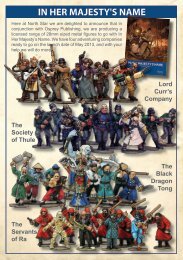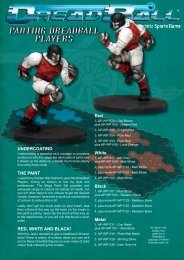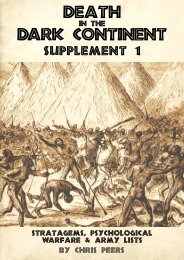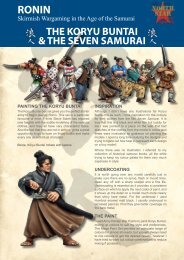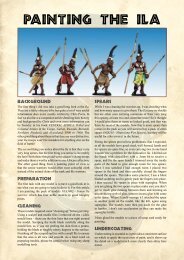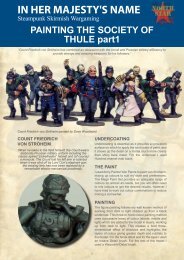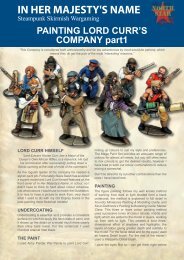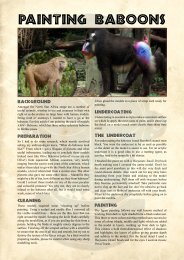The British Army in the Restoration Period.pdf
The British Army in the Restoration Period.pdf
The British Army in the Restoration Period.pdf
Create successful ePaper yourself
Turn your PDF publications into a flip-book with our unique Google optimized e-Paper software.
<strong>The</strong> <strong>British</strong> <strong>Army</strong> <strong>in</strong> <strong>the</strong><br />
<strong>Restoration</strong> <strong>Period</strong><br />
1660-1680<br />
<strong>The</strong> wonderful th<strong>in</strong>g about our North Star 1672 range is that <strong>the</strong> figures will do for many different nations armies <strong>in</strong> <strong>the</strong><br />
period 1665-1680. This is because it is a time just before uniforms, and <strong>the</strong> figures are all dressed <strong>in</strong> <strong>the</strong> fashions common<br />
amongst soldiers throughout Western Europe. This of course <strong>in</strong>cludes Brita<strong>in</strong>.<br />
<strong>The</strong> years covered by our range is called <strong>the</strong> <strong>Restoration</strong> <strong>Period</strong> <strong>in</strong> Brita<strong>in</strong> as it was <strong>the</strong> time <strong>the</strong> monarchy, represented by<br />
Charles II, was restored after <strong>the</strong> English Civil War.<br />
It was also <strong>the</strong> genesis of <strong>the</strong> <strong>British</strong> <strong>Army</strong>. Brita<strong>in</strong>, tired of soldiers and war, had disbanded much of it’s forces after <strong>the</strong><br />
Civil War and Oliver Cromwells reign. With <strong>the</strong> return of Charles II to England <strong>in</strong> 1660, <strong>the</strong> units still under arms swore<br />
allegiance to <strong>the</strong> K<strong>in</strong>g and became <strong>the</strong> senior units of <strong>the</strong> <strong>British</strong> <strong>Army</strong>.<br />
Some of <strong>the</strong> <strong>in</strong>fantry regiments:<br />
Coldstream Guards<br />
Grenadier Guards<br />
Scots Guards<br />
1st Regiment (Royal Scots)<br />
2nd Regiment (<strong>The</strong> Queen’s)<br />
3rd Regiment (<strong>The</strong> Buffs)<br />
Pa<strong>in</strong>t<strong>in</strong>g <strong>the</strong> Early <strong>British</strong><br />
Infantry Regiments<br />
Coldstream Guards<br />
Coldstream Guards pikemen<br />
History<br />
<strong>The</strong> Coldstream Guards were created from <strong>the</strong> regiment<br />
of George Monck, a survivor of Cromwell’s New Model<br />
<strong>Army</strong>. <strong>The</strong> name comes from <strong>the</strong> fact Monck marched his<br />
regiment from <strong>the</strong> village of Coldstream on <strong>the</strong> Scottish<br />
border to London to support <strong>the</strong> restored K<strong>in</strong>g Charles II.<br />
Uniforms<br />
<strong>The</strong> musketeers of <strong>the</strong> Coldstream Guards are dressed <strong>in</strong><br />
<strong>the</strong> scarlet coats synonymous with <strong>the</strong> <strong>British</strong> <strong>Army</strong>, with<br />
green cuffs, breeches and stock<strong>in</strong>gs. Attractively, <strong>the</strong> pikes<br />
are dressed <strong>in</strong> reverse colours, that be<strong>in</strong>g Green Coats with<br />
red cuffs, breeches and stock<strong>in</strong>gs.<br />
Flags<br />
<strong>The</strong> flags of <strong>the</strong> Coldstream Guards were pla<strong>in</strong> blue for <strong>the</strong><br />
Colonels Colour, and a red cross l<strong>in</strong>ed with white on a blue<br />
field for <strong>the</strong> Regimental Colour.<br />
Coldstream<br />
Guards<br />
musketeers
<strong>The</strong> Buffs<br />
History<br />
<strong>The</strong> Buffs were orig<strong>in</strong>ally Duke of York and Albany’s<br />
Maritime Regiment of Foot, also known as Lord High<br />
Admiral’s Regiment. <strong>The</strong>y are also <strong>the</strong> forerunners of <strong>the</strong><br />
Royal Mar<strong>in</strong>es as <strong>the</strong>y were on duty as soldiers on ships<br />
dur<strong>in</strong>g <strong>the</strong> Anglo-Dutch Wars of <strong>the</strong> 1660’s. Because <strong>the</strong>y<br />
were onboard ships, <strong>the</strong> regiment did not have pikemen<br />
and were issued with fl<strong>in</strong>tlocks ra<strong>the</strong>r than matchlocks.<br />
Famously <strong>the</strong>y were commanded by John Churchill,<br />
ancestor of <strong>the</strong> 20th Century Churchill, but as <strong>the</strong> Duke of<br />
Marlborough he is just as great a historical figure.<br />
Buffs musketeer<br />
and Officer.<br />
Uniforms<br />
This regiment was dressed <strong>in</strong> a yellow coat with red cuffs,<br />
breeches and stock<strong>in</strong>gs.<br />
Flag<br />
Colonel Colour is yellow, <strong>the</strong> regimental colour a red cross<br />
l<strong>in</strong>ed white on a yellow field.<br />
Royal Scots<br />
History<br />
<strong>The</strong> Royal Scots were orig<strong>in</strong>ally a Scottish regiment that<br />
before our period had served <strong>in</strong> wars on <strong>the</strong> Cont<strong>in</strong>ent for<br />
three decades. Charles II recalled <strong>the</strong>m on his restoration,<br />
putt<strong>in</strong>g <strong>the</strong>m under Crown service, but sent <strong>the</strong>m back to<br />
France with <strong>the</strong>ir Colonel, Douglas, to fight for his ally <strong>the</strong><br />
French K<strong>in</strong>g Louis XIV.<br />
Uniforms<br />
<strong>The</strong> Royal Scots (Known <strong>the</strong> Douglas Regiment <strong>in</strong> this<br />
period) wore scarlet coats with white cuffs. Breeches and<br />
stock<strong>in</strong>gs were grey. This was for both musketeers and<br />
pikemen.<br />
Flags<br />
<strong>The</strong> Douglas Regiment here are shown carry<strong>in</strong>g <strong>the</strong> flag of<br />
<strong>the</strong>ir first colonel, Hepburn, <strong>the</strong> same flags <strong>the</strong>y had carried<br />
<strong>in</strong> <strong>the</strong> Thirty Years War. Just after our period, 1680, <strong>the</strong><br />
Douglas Regiment took up <strong>the</strong> Scottish Saltaire.<br />
Royal Scots pikeman,<br />
officer and Musketeer.<br />
<strong>The</strong> Douglas Regiment here<br />
are shown carry<strong>in</strong>g <strong>the</strong> flag<br />
of <strong>the</strong>ir first colonel.
<strong>The</strong> Royal English Regiment<br />
History<br />
<strong>The</strong> Royal English Regiment was raised <strong>in</strong> 1672 for service<br />
<strong>in</strong> France as part of Charles II alliance with Louis XIV.<br />
<strong>The</strong>y fought <strong>in</strong> <strong>the</strong> French Dutch War until be<strong>in</strong>g recalled<br />
to England <strong>in</strong> 1678. <strong>The</strong>y were commanded by James<br />
Monmouth, later made <strong>in</strong>famous by his Rebellion aga<strong>in</strong>st<br />
James II, and <strong>in</strong>cluded <strong>the</strong> future Duke of Marlborough,<br />
later <strong>the</strong> deadly foe of Louis XIV, but here as a brave<br />
young Ensign.<br />
Uniforms<br />
<strong>The</strong>re is evidence that <strong>the</strong> Royal English were kitted out<br />
by <strong>the</strong> French, so were given Grey coats with Blue Cuffs,<br />
Blue breeches and Grey stock<strong>in</strong>gs. This is for both <strong>the</strong><br />
musketeers and pikemen.<br />
Flags<br />
<strong>The</strong> Royal English carried <strong>the</strong> St George Cross with <strong>the</strong><br />
Royal Crown <strong>in</strong> <strong>the</strong> centre, perhaps with Charles’ cipher<br />
as well.<br />
Officers<br />
Regimental Officers, <strong>in</strong>clud<strong>in</strong>g Ensigns, dur<strong>in</strong>g this period<br />
were encouraged by <strong>the</strong>ir Sovereigns to wear Regimental<br />
colours. Where <strong>the</strong>y did, <strong>the</strong>y would have a better quality<br />
of cloth, l<strong>in</strong>ed with silver or gold lace. But many would<br />
still wear <strong>the</strong>ir civilian clo<strong>the</strong>s, at <strong>the</strong> height of fashion of<br />
course.<br />
<strong>British</strong><br />
Regimental<br />
Officers,<br />
<strong>in</strong>clud<strong>in</strong>g an<br />
Ensign, still<br />
wear<strong>in</strong>g <strong>the</strong>ir<br />
civilian clo<strong>the</strong>s,<br />
at <strong>the</strong> height of<br />
fashion of course!<br />
Royal English<br />
pikeman, officer<br />
and Musketeer.<br />
O<strong>the</strong>r Cloth<strong>in</strong>g &<br />
Equipment<br />
Shirts, lace and neck scarves were almost always white.<br />
<strong>The</strong> best quality worn by officers would be whiter than<br />
that of <strong>the</strong> men.<br />
Lea<strong>the</strong>r gloves, straps, pouches and o<strong>the</strong>r accoutrements <strong>in</strong><br />
various natural brown or buff coloured lea<strong>the</strong>rs. Officers<br />
may expensive coloured alternatives covered <strong>in</strong> fabric.<br />
Some cartridge boxes <strong>in</strong> black.<br />
Shoes, dark brown or black lea<strong>the</strong>r. Officers may expensive<br />
coloured alternatives covered <strong>in</strong> fabric. Shoelaces could<br />
be black, grey or more attractively coloured to match<br />
uniform.<br />
Musketeers' apostles are made of wood, but could be<br />
pa<strong>in</strong>ted bright colours.<br />
Pikes and muskets <strong>in</strong> natural wood, note <strong>the</strong> muskets of<br />
this period have a wooden ramrod.<br />
Fur<strong>the</strong>r Sources<br />
<strong>The</strong> Osprey Book <strong>The</strong> <strong>British</strong> <strong>Army</strong><br />
1660-1704<br />
Two Great Blogs<br />
http://warsoflouisxiv.blogspot.co.uk/<br />
http://rampjaar.blogspot.co.uk/<br />
And one very<br />
useful forum.<br />
http://www.leagueofaugsburg.com/<br />
fight<strong>in</strong>gtalk/viewforum.phpf=6



